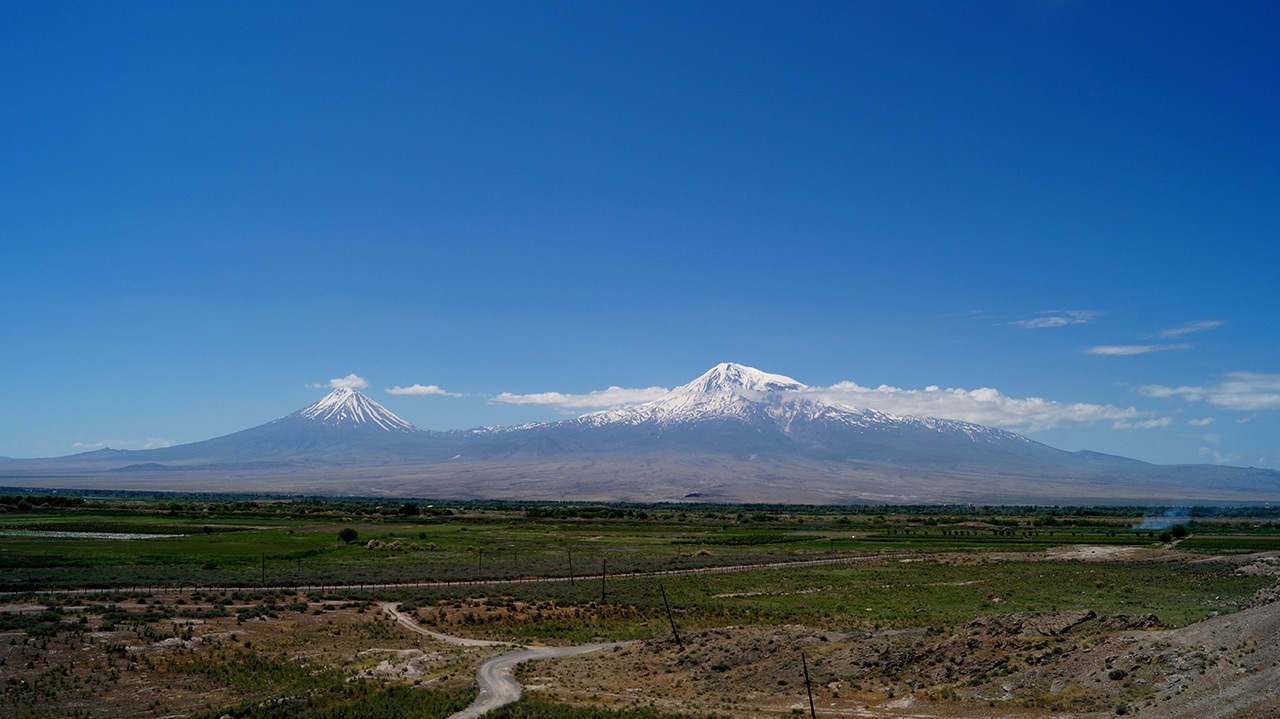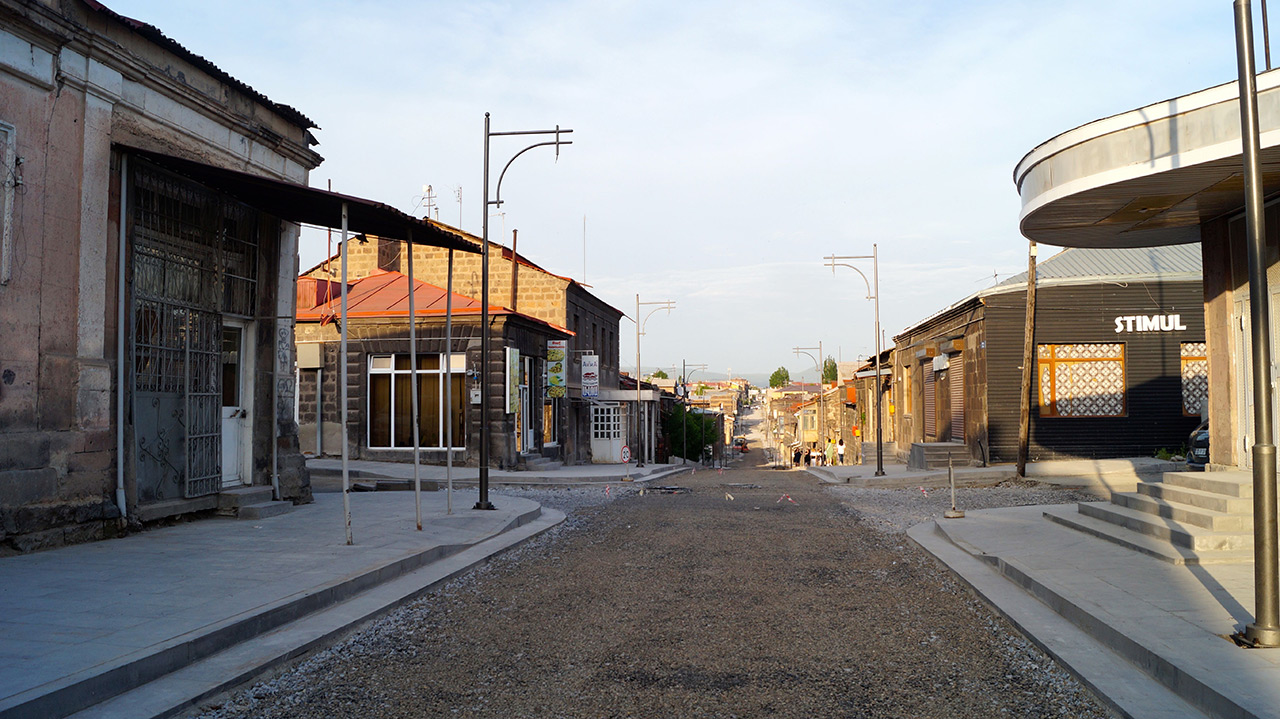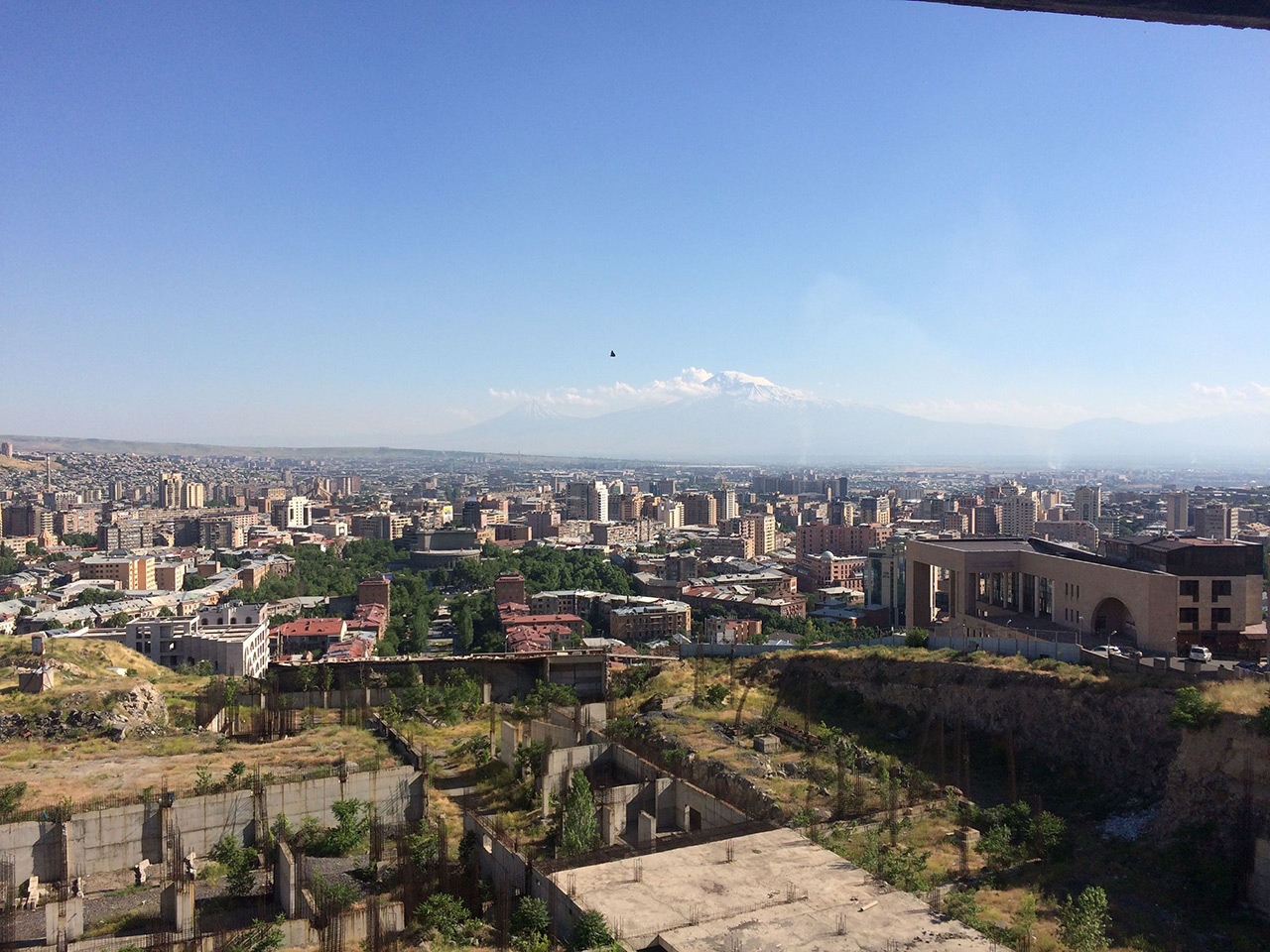by Daniel Kopp

Mount Ararat and the Ararat Valley, photo: Daniel Kopp
The landlocked country in the Caucasus has a huge potential — and multi-layered interest — to accelerate its green energy transition.
Armen Kirakosyan sits at his desk in the small backyard office in the northern outskirts of Yerevan, surrounded by shelves stuffed with books, some hidden behind photographs of — horses. Kirakosyan is an engineer, who with a few friends from Yerevan Polytechnic University established ‘Ayrudzy’ horse farm in the town of Ashtarak in 1980, which later developed into a horse riding club. Combining his love for horses and engineering, Ayrudzy became an NGO in 2007 to develop energy cooperatives in Armenia. Only recently, they installed 9 solar PV panels at their club.
When asked about his motivation to found a renewable energy cooperative, the 60-something fills his pipe, lights it and takes a few puffs. He recounts walking through the Ararat valley, south-west of Yerevan near the Aras river describing that today, the tree line in the valley lies two or three hundred meters higher than 30 or 40 years ago. “The climate is changing, and now in Ararat valley, we have a desert situation,” Kirakosyan says. He believes that energy cooperatives can be part of the solution to address global warming by reducing Armenia’s dependence on natural gas. Apart from that, Kirakosyan adds he also just finds new technology exciting — he’s an engineer after all.

Lake Sevan, the biggest freshwater reservoir in the region and a central part of Armenia’s ecosystem, photo: Daniel Kopp
While Armen Kirakosyan has clear ideas about how Armenians can tackle the climate crisis, the issue itself can’t yet count on the awareness of the Armenian population at large. The country does have a long history of environmental mobilisations, but most of them have targeted localised problems that, for instance, affect the country’s rivers, lakes and forests. Recently, citizens of the spa town of Jermuk blocked the road to the infamous Amulsar gold mine, which threatens to pollute the water in the area. This presents only the latest instance in a chain of environmental battles.
Armenia’s new green government?
The fact that global warming hasn’t really featured high on the general public’s agenda shouldn’t really take anyone by surprise. Armenia remains a country where greenhouse gas emissions lie far below the ceiling that the Paris Agreement foresees for the country. More importantly, however, Armenians had other problems to focus on: it was only a year and half ago that Armenian society began to free itself from a corrupt political elite in the social media-driven ‘Velvet Revolution’.
Since then, the new Armenian government under former opposition leader Nikol Pashinyan has rooted out systemic corruption from the top — even opposition MPs agree on that — and ushered in attempts to reform the economy, education, health and other sectors. One can sense an atmosphere of hope but also high expectations in the country.
Crucially, Pashinyan has also made the case for accelerating Armenia’s green energy transition and, in his government’s 5-year economic plan, foresees solar energy to cover 10% of the country’s total energy consumption in 2024. The country has huge untapped potential for green energy — hydro, solar and wind power. That’s particularly true for solar: according to government statistics, Armenia receives 1,720 kilowatt hours per square meter of sunlight every year, compared to an average of 1,000 in Europe.
Pashinyan’s plans to diversify Armenia’s energy supply, however, aren’t entirely new. Previous governments already encouraged the development of renewable energy as early as in 2003. So these plans might be less rooted in the urgency to tackle global warming but rather in Armenia’s recent history and geopolitical situation.
The energy crisis of the early 1990s
‘A small country with limited resources’ — when talking to Armenians about their country’s geopolitics, one can often hear variations of this very phrase. Unlike its eastern neighbour Azerbaijan, the landlocked country doesn’t have any indigenous fossil resources like oil or gas to provide a steady and independent energy supply. In its recent past lack of domestic resources put Armenia through a ‘dark’ period, still influencing its politics today.
In 1988, shortly before the fall of the Soviet Union, a devastating earthquake caused at least 25,000 deaths in the north-western part of the Armenian Soviet Socialist Republic. With the Chernobyl disaster two years earlier in mind, Soviet leader Mikhail Gorbachev decided to close down Armenia’s Metsamor Nuclear Power Plant, which was located a mere 100 km from the earthquake’s epicentre.

The city of Gyumri was almost totally destroyed in the 1988 earthquake. And even in 2019, not all parts have been reconstructed. Photo: Daniel Kopp
Then, Armenia was connected to the Trans-Caucasus electrical grid and received gas and oil from Azerbaijan to compensate for the closure of Metsamor. As an effect of the dissolution of the Soviet Union, the shortage of domestic energy sources became a real problem. In late 1991, tensions over Nagano-Karabakh, a disputed territory between freshly independent Armenia and Azerbaijan, reached a peak. Azerbaijan, and later its ally Turkey, closed their borders and put a fuel embargo on Armenia. This, in turn, led to a severe energy crisis lasting until 1995 when Metsamor was finally reactivated. During this time Armenian industry collapsed and GDP dropped by more than 50%. So did GHG emissions — by more than 70%, remaining stable every since. When asked, Armenians still remember these times with disbelief, recounting how they could use electricity for merely one or two hours per day and often resorted to candles illuminating their houses at night.
Energy has a socially explosive potential
The borders with Turkey and Azerbaijan remain closed to this day. In effect, Armenia’s energy supply is largely dependent on natural gas from Russia, transported via a pipeline through Georgia and transformed into electricity by thermal power plants. Most cars in the country are also fuelled by natural gas. In 2016, Armenia was only able to cover 34% of its energy demand with domestic energy sources.
While the country’s energy crisis in the early 90s might not be constantly present in the minds of Armenians, the energy question still has a socially explosive potential. When in June 2015, the Electric Networks of Armenia, largely owned by Russian state-owned companies, announced a price hike of more than 17% in electricity prices, thousands of Armenians took to the streets in the country’s capital in what was dubbed “Electric Yerevan” protests. After a week of protests and a heavy-handed response by the riot police, the price hikes were suspended and the Electric Networks of Armenia sold to the Armenian-Russian oligarch Samvel Karapetyan. Similarly, Pashinyan finds himself in volatile negotiations with Vladimir Putin on gas prices after they had been increased by 10% in January 2019.
The Electric Yerevan protests reflected a bigger socio-economic problem in the country, the widespread energy poverty: around 30% of the country’s population can be considered energy poor, having to spend more than 50% of income on energy and heating. With an average income of around 400 USD, Armenian families often spend more than 100 USD on heating alone. Oftentimes they don’t even heat whole apartments, but just the common areas. In the rural parts of the country in particular, this leads poor families to not heat with expensive gas but with cheaper wood instead — contributing to already high levels of deforestation.
It’s because of these various reasons — Armenia’s lack of fossil resources, its history of energy insecurity and socio-economic problems like energy poverty — that Armenian governments have developed a high interest in diversifying the energy supply, notably through renewable energy sources. At the same time, the energy sector is by far the biggest emitter of greenhouse gases, having accounted for 70.3% of all emissions in 2012. Bearing this in mind, it seems that climate change mitigation, alleviating socio-economic problems and the country’s national security interest could go hand in hand.
The potential and limitations of green energy
Member of Parliament Mikayel Zolyan, who sits on the Parliament’s Foreign Affairs Standing Committee, not only reaffirms the country’s interest in renewable energy, but also the danger of its old Metsamor nuclear reactor, which the European Union has consistently argued should be phased-out. Referring to the EU’s stance, however, Zolyan clarifies that as long as there’s no massive financing effort, Armenians have no other option than to keep Metsamor running or else return to the dark days of energy shortages. With regards to global warming, Zolyan’s sentiment is also reflected in Armenia’s First Biennial Update Report under the United Nations Framework Convention on Climate Change, the framework under which the Paris Agreement was signed in 2015. The report’s projections rely on a new nuclear reactor to deliver about 63% of mitigation in the energy sector until 2030.
Astghine Pasoyan, an economist at the Energy Saving Foundation, is also sceptical of the hype around solar energy. According to her, apart from a new nuclear reactor, a stronger focus on the demand side would turn out more cost effective to reduce emissions in the short term. For instance, most residential buildings in Armenia have been built during Soviet times when energy was cheap and readily available. Making them more energy efficient could go a long way reducing demand: a recent UNDP pilot project saw a multi-apartment building insulated, saving up to 58% of energy and lowering costs by 60% for residents.

Yerevan’s housing stock includes mostly Soviet-era buildings with low energy efficiency, photo: Daniel Kopp
Nevertheless, Pasoyan does see real potential in green energy in the medium and long term to lower gas demand. She helps municipal governments to set up green roadmaps — plans for local green development — which often attract grants instead of loans by international donors. In particular, setting up public green energy projects could allow municipalities to provide public buildings with cheaper energy, create jobs and use their budget for local development instead of paying the gas bills.
In the end, with regard to the green energy transition in Armenia, one thing is clear: it will need a lot of money to succeed. Whether it’s in the form of the EU’s external investment funds, grants from development banks or even a Global Green New Deal, rich countries will need to provide investment to drive the transition.
There are some good signs. The European Investment Bank has recently adopted a new lending policy, intending to phase-out the funding of fossil fuels until 2021 and ‘increasing the impact of investment to support energy transformation outside the EU’. Similarly, the EU’s new Neighbourhood Policy Instrument (NDICI), currently under negotiations for the next EU budget, aims to streamline investments and operations with regard to climate change. And discussions about the future of the Eastern Partnership, which Armenia and five other countries in Europe’s East are part of, certainly bear the potential for increased ambitions to tackle the climate crisis. In Armenia, there is certainly a multi-faceted interest to move quickly towards the green energy transition.
 Daniel Kopp is the Executive Editor of International Politics and Society magazine, where he focuses on European politics, environmental issues and the Global South. He studied Comparative Literature and Philosophy in Bonn, Oxford and St Andrews, having received a bi-national master’s degree (MA/MLitt) from Bonn and St Andrews.
Daniel Kopp is the Executive Editor of International Politics and Society magazine, where he focuses on European politics, environmental issues and the Global South. He studied Comparative Literature and Philosophy in Bonn, Oxford and St Andrews, having received a bi-national master’s degree (MA/MLitt) from Bonn and St Andrews.
